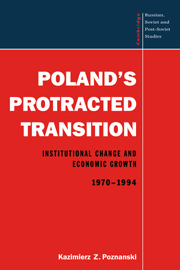Book contents
- Frontmatter
- Contents
- Preface
- Introduction: Research agenda, conceptual model and principal findings
- Part I Imperfect decentralization, broken political contracts and foreign-debt crisis
- Part II Economic reforms, divided society and ‘growth fatigue’
- 4 Anti-crisis policies and elusive economic recovery
- 5 Foreign trade developments: underutilized potential
- 6 Political struggles and economic malaise
- Part III Communist legacy, ‘shock therapy’ and economic recession
- Appendix
- Notes
- References
- Index
- Titles in the series
5 - Foreign trade developments: underutilized potential
Published online by Cambridge University Press: 29 October 2009
- Frontmatter
- Contents
- Preface
- Introduction: Research agenda, conceptual model and principal findings
- Part I Imperfect decentralization, broken political contracts and foreign-debt crisis
- Part II Economic reforms, divided society and ‘growth fatigue’
- 4 Anti-crisis policies and elusive economic recovery
- 5 Foreign trade developments: underutilized potential
- 6 Political struggles and economic malaise
- Part III Communist legacy, ‘shock therapy’ and economic recession
- Appendix
- Notes
- References
- Index
- Titles in the series
Summary
That Poland during the years of Jaruzelski's political rule permitted its debt problems to increase further, and proved unable to return to a sustainable dynamic growth in production, could be viewed by some as additional evidence of the scope of import misuse by Gierek's government. However, we have earlier raised doubts about the import misuse leading to the 1979–82 crisis, suggesting that partial immobilization of export potential may have been a more critical factor behind the output decline. In this chapter we will look for possible signs that this type of immobilization continued into the post-1982 period, indicating that during this stage of development Poland's actual export potential prepared the economy for better performance than it actually achieved.
We have found a comparative perspective most suitable for the task we have taken on in this chapter, including a look at the type of repayment strategies employed by various heavily indebted state-planned economies of Eastern Europe as well as in the largely market-based or mixed-type economies of many developing countries. It follows from this chapter that like a number of countries in Eastern Europe, Poland chose, or was forced, to rely in its repayment strategy on import reductions combined with sluggish, or declining exports to hard-currency markets. While Poland followed this import-substitution version of ‘restrictive’ adjustment, heavily indebted South Korea and Taiwan did not allow their imports to fall while accelerating exports. Many Latin American economies, in turn, executed rather considerable import reduction, but most of the repayment came from export mobilization (e.g., in Brazil).
- Type
- Chapter
- Information
- Poland's Protracted TransitionInstitutional Change and Economic Growth, 1970–1994, pp. 115 - 138Publisher: Cambridge University PressPrint publication year: 1997



